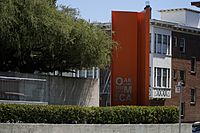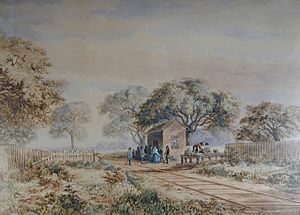Oakland Museum of California facts for kids
The Oakland Museum of California, also known as OMCA, is a special museum in Oakland, California. It brings together art, history, and natural science from California all in one place. You can find it at 1000 Oak Street. The museum has more than 1.8 million items that help tell the amazing story of California.
Contents
History of OMCA
The OMCA started in 1969. It was formed by combining three smaller museums in the area. These were the Oakland Public Museum, the Oakland Art Gallery, and the Snow Museum of Natural History. The idea to combine them began in 1954. These three groups wanted to put all their collections together under one roof.
This plan finally came true in 1961. Voters in Oakland approved a $6.6 million bond. This money helped start building the OMCA campus. The museum is located near Lake Merritt in the center of the city.
When the museum was founded, it was called a "people's museum." This meant it wanted to show the many different communities in Oakland. This idea was very much shaped by the social changes happening in the late 1960s. During that time, the Civil rights movement was very active.
Because of this focus on community, the first director, Jim Holliday, wanted to create a special committee. This committee would include people from the community. Their job would be to help make important decisions for the new museum. However, Holliday was removed from his job before the museum even opened. This caused some upset among the museum staff.
The issues continued into the 1970s. Some community members even decided not to visit the museum. To help fix this, OMCA hired a local artist named Ben Hazard. He worked with the community to create the Cultural and Ethnic Affairs Guild. This group helped plan events at the museum. They also formed many committees based on different ethnic groups. These committees still help guide how the museum works today.
Museum Building and Facilities
The museum building was designed by architect Kevin Roche. The outdoor areas were designed by Dan Kiley and Geraldine Knight Scott. The building is a great example of "mid-century modern" style. This style mixes indoor and outdoor spaces.
The concrete building has three levels. Each level focuses on a different collection: art, history, or natural science. There are also galleries for temporary exhibits. The museum has an auditorium, a restaurant, and other helpful spaces. Outside, you can find terraced roof gardens, patios, and outdoor sculptures. There is also a large lawn and a koi pond.
Between 2009 and 2013, the museum had a big renovation. This project updated and expanded the building. The art and history galleries were closed for a while. Then the natural science gallery and education areas were updated. The museum also planned to update its outdoor areas. This project, completed by late 2020, opened up the courtyard. It also added a new entrance facing Lake Merritt. This helps connect the museum better to the neighborhood.
Museum Collections
The OMCA has amazing collections that tell California's story.
California Art Collection
The museum has over 70,000 pieces of California art and design. These works were created from the mid-1800s to today. Some famous painters in the collection include Albert Bierstadt, Richard Diebenkorn, Maynard Dixon, and William Keith. You can also see art by Wayne Thiebaud and the "Society of Six" artists.
The museum also holds the personal collections of Dorothea Lange. She was a very famous photographer. Her collection includes thousands of photos, notes, and personal items. On the museum's rooftop, you can see a large yellow peace sign sculpture. It's called "Big Peace IV" by Tony Labat.
Craftsman Movement Art
The museum has a special collection of art from the American Craftsman movement. This includes many paintings and decorative items by Arthur Mathews and his wife Lucia Kleinhans Mathews. The museum has over 500 paintings, drawings, and furniture pieces by them. It also keeps their notes and sketches.
California History Collection
The history collection has more than 1.8 million items. They show California's history and cultures. This includes items from before Europeans arrived, all the way to the 21st century. Some of the strongest parts of this collection are:
- Photographs
- Native Californian baskets and other items
- Artifacts from the California Gold Rush era
- Items related to California's technology, farming, business, and daily life
- Objects from important events like World War II
The Native Californian basket collection has about 2,500 baskets. They come from different parts of California and different Native American groups. A special part of the collection is an Ohlone basket. It was made for the museum in 2010 by Ohlone artist Linda Yamane.
California Natural Sciences Collection
The Natural Sciences Department shows why California is a "biodiversity hotspot." This means it has the greatest variety of living things in the entire nation. The collection has over 100,000 research specimens and other items. These include:
- Over 10,000 insect specimens
- More than 5,000 shells
- Over 2,000 bird and mammal study skins
- Several thousand bird eggs
- More than 3,180 plant specimens
- Many freeze-dried exhibit specimens
- Collections of reptiles, amphibians, fish, and other animals
Original Museums
The Oakland Public Museum first opened in the nearby Camron-Stanford House in 1910. Its first curator, Charles P. Wilcomb, collected items about Native Americans and settlers from the East Coast. The Oakland Art Gallery opened in 1916. The Snow Museum of Natural History opened in 1922. Even though the OMCA now focuses on California, it still has some older items from outside the state. These include a collection of snuff bottles and a carved jade pagoda.
See also
 In Spanish: Oakland Museum of California para niños
In Spanish: Oakland Museum of California para niños




